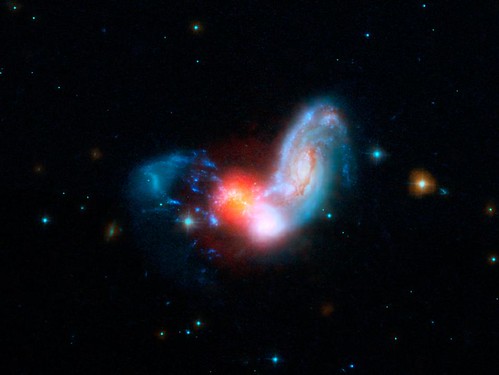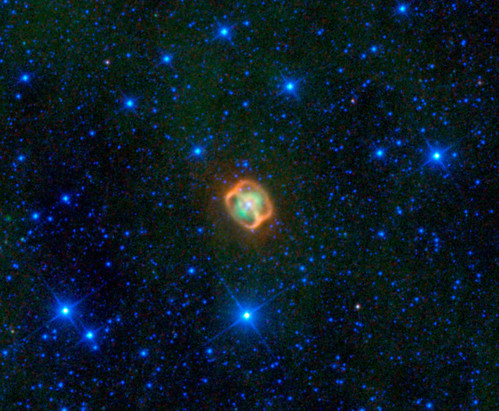Awesomeness Round-up – 11/29/10
- By Maggie Masetti
- November 29, 2010
- Comments Off on Awesomeness Round-up – 11/29/10
Two colliding spiral galaxies triggered a burst of star formation called a “starburst” (not like the candy). This one is the brightest ever seen away from the center of a galaxy merger. This image of these two galaxies (which are collectively known as II Zw 096) is a combination of Hubble Space Telescope and Spitzer Space Telecope images. The galaxies themselves can be clearly seen at shorter wavelengths of light from Hubble (blue hues). Infrared Spitzer data (in red) shows the star forming activity. The brightest glow is about 700 light-years across – though that’s just a small portion of the 50,000 light-year spread of the galaxies. Read the NASA release for more information about the image!

Image credit: NASA/JPL-Caltech/STScI
Here’s another cool infrared image – this time it’s data from WISE. It’s hard to tell what this is, but it’s actually a planetary nebula. A planetary nebula is actually the result of a star, like the sun, going red giant, and then losing a lot of its mass from stellar wind, exposing the hot core of the old star. Planetary nebulae can take on all sorts of cool forms. This one appears to have rings. What caused the rings? Head over to Phil Plait’s blog for his take on this cool astronomical phenomena.
This image was also captured by WISE, of “runaway star” AE Aurigae. Scientists suspect that a collision sent this star hurtling through space from its original home in the Trapezium cluster. Here, they’ve captured it surrounded by the aptly-named Flaming Star nebula, IC405.

Image Credit: NASA/JPL-Caltech/UCLA
Our friends with the Solar Dynamics Observatory released this video last week – it shows a snaking, slithery filament that’s been writhing around on the surface of the Sun. Captured in extreme ultraviolet light over a 3-day period, the video shows the intense activity of our nearest star.



